
Amos Jerome Snell Hall and Charles Hitchcock Hall, more commonly known as Snell–Hitchcock, make up a residence hall at the University of Chicago. The dorm is on the northwest corner of the University's main quadrangles at the corner of 57th St. and Ellis Avenue. It is connected via emergency exits to Searle Chemistry Laboratory. Built in 1892 (Snell) and 1901 (Hitchcock), they are the oldest residence halls still in use as such on the university's campus. Snell is built in a Collegiate Gothic style, while Hitchcock is Prairie Style-inspired Gothic. The buildings feature fireplaces and exteriors of limestone, as well as hardwood molding and trim.

The Seward Hotel, also known as the Governor Hotel, is a historic hotel building in downtown Portland, Oregon, United States, that is listed on the National Register of Historic Places (NRHP). Built in 1909, it is one of two NRHP-listed buildings that make up the Sentinel Hotel, the other being the 1923-built Elks Temple. The Seward was renamed the Governor Hotel in 1931, closed in the mid-1980s, and reopened in 1992 joined with the former Elks building, and thereafter formed the east wing of a two-building hotel.

The U.S. Grant Hotel is a historic and one of the oldest hotels in downtown San Diego, California operating under a franchise of Marriott International as part of their Luxury Collection brand. It is listed on the National Register of Historic Places. It is 11 stories high and has 270 guest rooms in addition to meeting rooms and multiple ballrooms.

The Sugar Hill Historic District is a historic district in Detroit, Michigan. It contains 14 structures located along three streets: East Forest, Garfield, and East Canfield, between Woodward Avenue on the west and John R. on the east. The district was listed on the National Register of Historic Places in 2003.
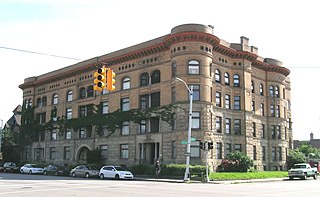
The Coronado Apartments are an apartment building located on 3751–73 Second Avenue in Midtown Detroit, Michigan. It was designated a Michigan State Historic Site in 1980 and listed on the National Register of Historic Places in 1982.

The Wilbraham is an apartment building at 282–284 Fifth Avenue and 1 West 30th Street in the Midtown South neighborhood of Manhattan in New York City. The nine-story structure was designed by David and John Jardine in the Romanesque Revival style, with elements of the Renaissance Revival style, and occupies the northwestern corner of 30th Street and Fifth Avenue. It was built between 1888 and 1890 as a bachelor apartment hotel. The Wilbraham is a New York City designated landmark and is listed on the National Register of Historic Places.

The Masonic Temple in downtown Casper, Wyoming is a Masonic hall, built in 1914 during a boom time initiated by the development of the Salt Creek Oil Field. Located on a corner site, the temple remains essentially as it was designed by Casper architect Homer F. Shaffer. The four story light-colored brick building rests on a raised basement and is topped by a crenelated parapet. The original windows have been replaced with vinyl units but retain the one-over-one appearance of the originals. Windows extend over the west and south sides. The north side is blank, while the east side is the building's rear facade and has fire escapes and a few windows.

The Soo Hotel was later known as the Princess Hotel, The Patterson Hotel Annex, The Hotel Dakotan, Heritage Recovery Center, and Heritage Apartments. It is a historic building located on Fifth Street North in Bismarck, North Dakota, United States, and was listed on the National Register of Historic Places in 1983. It was built by prominent businessman and political powerhouse Edward Patterson in 1906 as a second-class hotel to his other property, the high-class Northwestern Hotel. The four-floor, 76-room hotel was named after the Soo Line Railroad which had arrived in town in 1902 and whose depot was located several blocks away. It was briefly the tallest building in Bismarck.

The Fraser Mansion is a building at 1701 20th Street NW, at the intersection of Connecticut Avenue, 20th Street, and R Street in the Dupont Circle neighborhood of Washington, D.C. constructed in 1890 to be the George S. Fraser mansion, it served as his private residence for five years, a restaurant, a boarding house, the home of the new Founding Church of Scientology, and—currently—the location of Scientology's National Affairs office.

The Globe Building, Beebe Building and the Hotel Cecil are a trio of historic office/hotel buildings located in Downtown Seattle, Washington, United States. The buildings occupy the entire west side of the 1000 block of 1st Avenue between Madison and Spring streets. The three buildings were constructed from late 1900 to 1901 for Syracuse-based investors Clifford Beebe and William Nottingham by the Clise Investment Company, headed by businessman James Clise (1855–1938), as a result of the Alaska Gold Rush which fueled the construction of many such buildings in downtown Seattle.

The former Commercial Hotel is a historic hotel building in Wadena, Minnesota, United States, built circa 1885. It was listed on the National Register of Historic Places in 1988 for having local significance in the theme of commerce. It was nominated for being an excellent example of the lodging facilities built in anticipation of Wadena's late-19th-century economic growth.

The Colonial Hotel is a historic building in Seattle located at 1119-1123 at the southwest corner of 1st Avenue and Seneca Streets in the city's central business district. The majority of the building recognizable today was constructed in 1901 over a previous building built in 1892-3 that was never completed to its full plans.
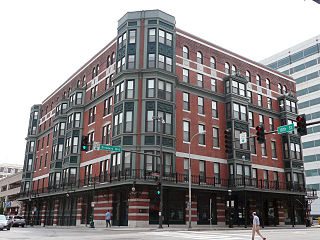
The Coates House Hotel is a former hotel at 1005 Broadway in downtown Kansas City, Missouri, on the National Register of Historic Places. Also known as the New Coates House Hotel, it was built in 1889–1891, incorporating parts of an earlier hotel, which had been built in the late 1860s as the Broadway Hotel and then became the Coates House after a change in ownership. In 1978, when it had become primarily single-room occupancy for transients, it burned in the deadliest fire in the city's history. It was subsequently restored and is now an apartment building.
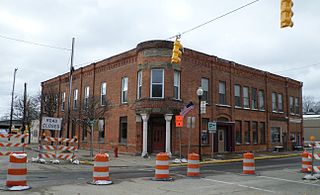
The Hotel Columbia is a former hotel building located at 194 East Huron Avenue in Vassar, Michigan. It was listed on the National Register of Historic Places in 1992. The building now houses a restaurant, the Riverside Grill.

The Lower Main Street Commercial Historic District in Boise, Idaho, is a collection of 11 masonry buildings, originally 14 buildings, that were constructed 1897-1914 as Boise became a metropolitan community. Hannifin's Cigar Store is the oldest business in the district (1922), and it operates in the oldest building in the district (1897). The only building listed as an intrusion in the district is the Safari Motor Inn (1966), formerly the Hotel Grand (1914).

The Union Block and Montandon Buildings in Boise, Idaho, are 2-story commercial buildings with rustic sandstone facades. The Romanesque Revival Union Block was designed by John E. Tourtellotte and constructed in 1901, and the Renaissance Revival Montandon Building was designed by J.W. Smith and constructed in 1908. Also known as the Fidelity-Union Block, the buildings were added to the National Register of Historic Places (NRHP) in 1979.

The Marion Allsup House in Boise, Idaho, was a 1-story, 5-room cottage designed by Tourtellotte & Co. and constructed in 1901. The house featured Colonial Revival or Neoclassical details, including narrow shiplap siding, a cross facade porch, and a pyramid roof. The Allsup House was the least elaborate design of all surviving houses from the Tourtellotte thematic group. The house was added to the National Register of Historic Places (NRHP) in 1982. The Allsup House either was demolished or renovated after its nomination and listing on the NRHP, and the current 2-story house at the site retains no similarity to the modest 1901 design drawn by Tourtellotte & Co.

Ponce de Leon Apartments is a historic apartment building in Atlanta, Georgia, United States. A part of the Fox Theatre Historic District, the building is located at the intersection of Peachtree Street and Ponce de Leon Avenue in midtown Atlanta. It was built by the George A. Fuller Company in 1913, with William Lee Stoddart as the building's architect. The building was designated a Landmark Building by the government of Atlanta in 1993.
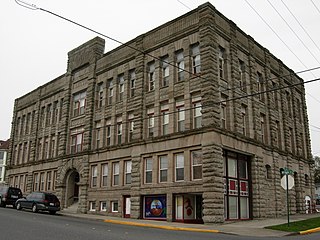
The Lottie Roth Block is an historic commercial building located near downtown Bellingham, Washington and is listed on the U.S. National Register of Historic Places. Built by quarry manager and Washington State Legislator Charles Roth and named after his wife, Lottie, the building is clad in the famous Chuckanut Sandstone from his Bellingham Bay Quarry that would be used in countless building projects across the region. Completed in 1891, it was one of the last large commissions of noted Northwest architect Elmer H. Fisher and his only project in Whatcom County. While initially built as an office/retail building in anticipation of the commercial expansion of the town of Whatcom, it was converted entirely to Apartments by 1918 when commercial development moved in the opposite direction towards New Whatcom, which after 1903 became the new city of Bellingham's downtown. Still strictly serving as a residential building to the current day, the Lottie Roth Block was listed on the National Register of Historic Places on December 12, 1978.
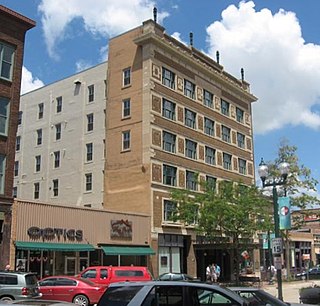
The Carpenter Building, historically the Carpenter Hotel or Hotel Carpenter and known colloquially as The Carpenter, is a historic building at 221 South Phillips Avenue in downtown Sioux Falls, South Dakota. Originally serving as a hotel from 1912 to 1966, it is now used for retail and apartment space. It was listed on the National Register of Historic Places in 1986.






















